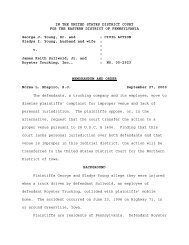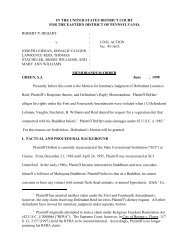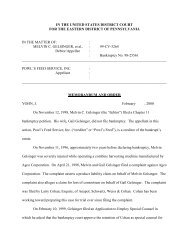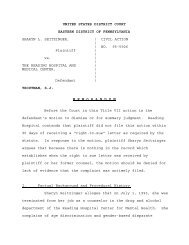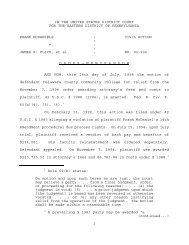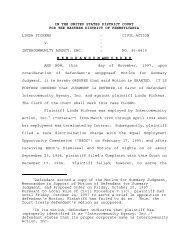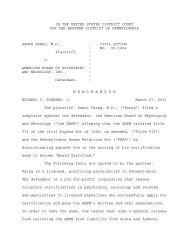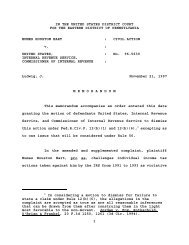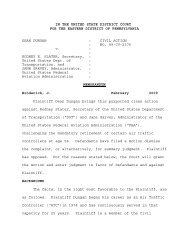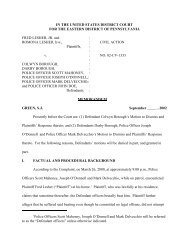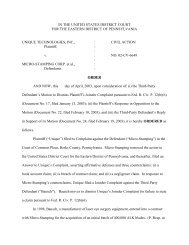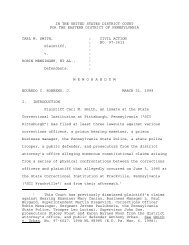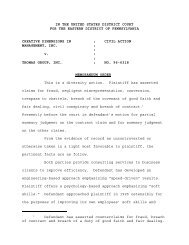Counts 1 and 2 of the complaint set forth the claims of plaintiff Puscar
Counts 1 and 2 of the complaint set forth the claims of plaintiff Puscar
Counts 1 and 2 of the complaint set forth the claims of plaintiff Puscar
Create successful ePaper yourself
Turn your PDF publications into a flip-book with our unique Google optimized e-Paper software.
IN THE UNITED STATES DISTRICT COURT<br />
FOR THE EASTERN DISTRICT OF PENNSYLVANIA<br />
MICHAEL P. PUSCAR <strong>and</strong> JOHN :<br />
J. PARDINI, :<br />
Plaintiffs, : CIVIL ACTION<br />
:<br />
v. : No. 96-CV-8442<br />
:<br />
HALE PRODUCTS, INC., :<br />
Defendant. :<br />
MEMORANDUM ORDER<br />
Presently before <strong>the</strong> Court are<br />
defendant's motion for summary judgment <strong>of</strong><br />
Count III (Age Discrimination in Employment<br />
Act claim) <strong>and</strong> motion to dismiss Count IV<br />
(Pennsylvania Human Relations Act claim) <strong>of</strong><br />
<strong>plaintiff</strong> Pardini's <strong>complaint</strong>. 1<br />
Upon<br />
consideration <strong>of</strong> defendant's motions <strong>and</strong><br />
<strong>plaintiff</strong> John J. Pardini's (“Pardini”)<br />
1<br />
<strong>Counts</strong> 1 <strong>and</strong> 2 <strong>of</strong> <strong>the</strong> <strong>complaint</strong> <strong>set</strong><br />
<strong>forth</strong> <strong>the</strong> <strong>claims</strong> <strong>of</strong> <strong>plaintiff</strong> <strong>Puscar</strong>; said<br />
<strong>claims</strong> are not <strong>the</strong> subject <strong>of</strong> <strong>the</strong> pending<br />
motions.
esponse <strong>the</strong>reto, defendant's motions will<br />
be denied.<br />
I. FACTS<br />
The material facts are not in dispute.<br />
Pardini was employed by defendant Hale<br />
Products Inc., from on or about May 26,<br />
1969, through August 23, 1993. On August<br />
23, 1993, his position as Plant Manager for<br />
defendant's Equipment Division was<br />
terminated; his job responsibilities were<br />
reassigned to a younger employee <strong>and</strong><br />
<strong>the</strong>reafter defendant failed to rehire him.<br />
Pardini timely filed a charge with <strong>the</strong><br />
Equal Employment Opportunity Commission<br />
("EEOC") claiming that <strong>the</strong> personnel<br />
decisions were made because <strong>of</strong> his age.<br />
On September 28, 1995, Pardini signed a<br />
2
eturn receipt for certified mail which<br />
contained a form <strong>of</strong> “right-to-sue letter.”<br />
The EEOC did not send a copy <strong>of</strong> <strong>the</strong> “rightto-sue<br />
letter” to Pardini’s counsel. The<br />
EEOC acknowledges that <strong>the</strong> “right-to-sue<br />
letter” was not intended but was<br />
inadvertently sent to Pardini as <strong>the</strong> result<br />
<strong>of</strong> a clerical error by <strong>the</strong> EEOC. 2<br />
After<br />
2<br />
In his affidavit, William D. Cook,<br />
Enforcement Manager for <strong>the</strong> Philadelphia<br />
District Office <strong>of</strong> <strong>the</strong> EEOC, states that<br />
<strong>the</strong> September 28, 1996 “right-to-sue<br />
letter” was issued as a result <strong>of</strong> clerical<br />
error. Mr. Cook states that Ms. Pinkey<br />
Lucas, <strong>the</strong> EEOC Investigator assigned to<br />
Pardini’s charge, informed him that “she<br />
had been unaware <strong>of</strong> <strong>the</strong> September 28, 1995<br />
Dismissal Notice <strong>and</strong> continued to process<br />
<strong>the</strong> Pardini charge <strong>the</strong>reafter as if it was<br />
an open charge.”<br />
Mr. Cook concludes “that <strong>the</strong> September<br />
28, 1995 Dismissal <strong>and</strong> Notice <strong>of</strong> Rights for<br />
Charge 170941121, even if actually received<br />
by all parties, was issued in error.<br />
Clearly, staff from both <strong>the</strong> Enforcement<br />
Unit <strong>and</strong> <strong>the</strong> Legal Unit continued to<br />
3
sending <strong>the</strong> September 28, 1995 “right-tosue<br />
letter” to Pardini, <strong>the</strong> EEOC continued<br />
to investigate <strong>and</strong> to process Pardini’s<br />
charge. Pardini’s counsel continued to<br />
communicate with <strong>the</strong> EEOC <strong>and</strong> provide it<br />
with information regarding his charge <strong>of</strong><br />
discrimination by defendant.<br />
On December 16, 1996, after completion<br />
<strong>of</strong> <strong>the</strong> EEOC investigation, <strong>the</strong> EEOC sent<br />
Pardini <strong>and</strong> his counsel a right-to-sue<br />
letter. On December 18, 1996, Pardini<br />
filed his <strong>complaint</strong>. In his <strong>complaint</strong>,<br />
process that charge <strong>the</strong>reafter in<br />
conjunction with <strong>the</strong> related <strong>Puscar</strong> charge<br />
<strong>and</strong> to treat both charges in <strong>the</strong> same<br />
manner, i.e., as open charges.” Mr. Cook<br />
“recommended to <strong>the</strong> District Director that<br />
she issue a Notice <strong>of</strong> Reconsideration <strong>and</strong><br />
Notice <strong>of</strong> Rescinding concerning <strong>the</strong><br />
September 28, 1995 Dismissal <strong>and</strong> Notice <strong>of</strong><br />
Rights” for Pardini’s charge.<br />
4
Pardini alleges that he was terminated <strong>and</strong><br />
not rehired by defendant because <strong>of</strong> his<br />
age. Pardini also contends that defendant<br />
fired him in reckless disregard <strong>of</strong> his<br />
rights under <strong>the</strong> Age Discrimination in<br />
Employment Act, 42 U.S.C. § 621 et seq.,<br />
<strong>and</strong> <strong>the</strong> Pennsylvania Human Relations Act,<br />
42 Pa. C.S.A. § 951 et seq.<br />
II. DISCUSSION<br />
Under Rule 56(c), summary "judgment<br />
sought shall be rendered <strong>forth</strong>with if <strong>the</strong><br />
pleadings, depositions, answers to<br />
interrogatories, <strong>and</strong> admissions on file,<br />
toge<strong>the</strong>r with affidavits, if any, show that<br />
<strong>the</strong>re is no genuine issue as to any<br />
material fact <strong>and</strong> that <strong>the</strong> moving party is<br />
entitled to a judgment as a matter <strong>of</strong> law."<br />
5
Fed. R. Civ. P. 56(c); Celotex Corp. v.<br />
Catrett, 477 U.S. 317, 106 S. Ct. 2548<br />
(1986). All <strong>of</strong> <strong>the</strong> facts must be viewed in<br />
<strong>the</strong> light most favorable to <strong>the</strong> non-moving<br />
party <strong>and</strong> all reasonable inferences must be<br />
drawn in favor <strong>of</strong> <strong>the</strong> non-moving party.<br />
The facts material to this motion are not<br />
in dispute; however, defendant is not<br />
entitled to judgment as a matter <strong>of</strong> law.<br />
The Age Discrimination in Employment Act<br />
states, in pertinent part,<br />
If a charge filed with <strong>the</strong> Commission<br />
[<strong>the</strong> EEOC] under this chapter is<br />
dismissed or <strong>the</strong> proceedings <strong>of</strong> <strong>the</strong><br />
Commission are o<strong>the</strong>rwise terminated<br />
by <strong>the</strong> Commission, <strong>the</strong> Commission<br />
shall notify <strong>the</strong> person aggrieved. A<br />
civil action may be brought under<br />
this section by a person defined in<br />
section 630(a) <strong>of</strong> this title against<br />
<strong>the</strong> respondent named in <strong>the</strong> charge<br />
within 90 days after <strong>the</strong> date <strong>of</strong> <strong>the</strong><br />
receipt <strong>of</strong> such notice.<br />
6
29 U.S.C. § 626(e). The ninety day period<br />
acts as a statue <strong>of</strong> limitations in which to<br />
bring <strong>the</strong> <strong>complaint</strong> in federal court. See<br />
Sperling v. H<strong>of</strong>fmann-La Roche, Inc., 24<br />
F.3d 463, 464 n.1 (3d Cir. 1994). The<br />
ninety day period begins to run when <strong>the</strong><br />
EEOC notifies <strong>the</strong> charging party <strong>of</strong> his<br />
right to sue. Said notice is authorized<br />
only after <strong>the</strong> Commission has in fact<br />
dismissed <strong>the</strong> complainant’s charges or in<br />
fact terminated its proceedings. 29 U.S.C.<br />
§ 626(e). Although <strong>the</strong> EEOC sent Pardini<br />
<strong>the</strong> September 28, 1995 “right-to-sue<br />
letter,” it did not dismiss his charge nor<br />
did it terminate its investigation into his<br />
charge. Defendant has not cited any<br />
authority which holds that <strong>the</strong> ninety day<br />
7
period begins to run when <strong>the</strong> EEOC, as <strong>the</strong><br />
result <strong>of</strong> a clerical error, unintentionally<br />
issues a “right-to-sue letter” to <strong>the</strong><br />
charging party. Only after <strong>the</strong> EEOC<br />
completed its investigation <strong>and</strong> issued <strong>the</strong><br />
December 16, 1996 right-to-sue letter did<br />
<strong>the</strong> ninety day period start to run.<br />
Accordingly, Pardini’s <strong>complaint</strong> is not<br />
time barred because no legal consequence<br />
attached to <strong>the</strong> September 28, 1995 letter.<br />
Moreover, even if I assume, as defendant<br />
argues, that <strong>the</strong> ninety day period began to<br />
run upon Pardini’s receipt <strong>of</strong> <strong>the</strong><br />
unintended September 28, 1995 “right-to-sue<br />
letter,” <strong>the</strong> manner in which <strong>the</strong> EEOC<br />
h<strong>and</strong>led Pardini’s charge effectively tolled<br />
<strong>the</strong> ninety day period. The ninety day<br />
8
period "is subject to waiver, estoppel <strong>and</strong><br />
equitable tolling." Schafer v. Board <strong>of</strong><br />
Public Education, 903 F.2d 243, 251 (3d<br />
Cir. 1990)(quoting Zipes v. Trans World<br />
Airlines Inc., 455 U.S. 385, 393, 102 S.<br />
Ct. 1127, 1132 (1982)). The Third Circuit<br />
has stated that <strong>the</strong> ninety day period in<br />
which a <strong>complaint</strong> is to be filed may be<br />
tolled "(1) where <strong>the</strong> defendant has<br />
actively misled <strong>the</strong> <strong>plaintiff</strong> respecting<br />
<strong>the</strong> <strong>plaintiff</strong>'s cause <strong>of</strong> action; (2) where<br />
<strong>the</strong> <strong>plaintiff</strong> in some extraordinary way has<br />
been prevented from asserting his or her<br />
rights; or (3) where <strong>the</strong> <strong>plaintiff</strong> has<br />
timely asserted his or her rights<br />
mistakenly in <strong>the</strong> wrong forum." Oshiver v.<br />
Levin, Fishbein, Sedran & Berman, 38 F.3d<br />
9
1380, 1387 (3d Cir. 1994). However, this<br />
list is not all inclusive. The EEOC’s<br />
failure to abide by its procedures is<br />
sufficient reason to equitably toll <strong>the</strong><br />
ninety day period; particularly, where as<br />
here, <strong>plaintiff</strong> continued to assert his<br />
rights before <strong>the</strong> EEOC. See Anderson v.<br />
Unisys Corp., 47 F.3d 302, 306-7 (8th Cir.<br />
1995), cert. denied, 116 S. Ct. 299 (1995). 3<br />
Accordingly, defendant’s motion for summary<br />
judgment <strong>of</strong> Count III will be denied.<br />
Additionally, this Court will continue to<br />
exercise supplemental jurisdiction over<br />
3<br />
Defendant argues that <strong>the</strong> EEOC is<br />
without authority to reconsider on its own<br />
motion. However, defendant does not<br />
address <strong>the</strong> EEOC’s power to correct a<br />
“right-to-sue letter” which was issued<br />
through clerical error. Nei<strong>the</strong>r statutory<br />
nor regulatory language prevents <strong>the</strong> EEOC’s<br />
from correcting a clerical error.<br />
10
Pardini’s Pennsylvania Human Relations Act<br />
claim. 28 U.S.C. § 1367(a). Defendant’s<br />
motion to dismiss Count IV will also be<br />
denied<br />
An appropriate order follows.<br />
11
IN THE UNITED STATES DISTRICT COURT<br />
FOR THE EASTERN DISTRICT OF PENNSYLVANIA<br />
MICHAEL P. PUSCAR <strong>and</strong> JOHN :<br />
J. PARDINI, :<br />
Plaintiffs, : CIVIL ACTION<br />
:<br />
v. : No. 96-CV-8442<br />
:<br />
HALE PRODUCTS, INC., :<br />
Defendant. :<br />
ORDER<br />
AND NOW, this 3rd day <strong>of</strong> September,<br />
1997, upon consideration <strong>of</strong> defendant's<br />
motions <strong>and</strong> <strong>plaintiff</strong> Pardini's response<br />
<strong>the</strong>reto, IT IS HEREBY ORDERED that<br />
defendant's Motion for Summary Judgment <strong>of</strong><br />
Count III <strong>of</strong> <strong>plaintiff</strong> <strong>complaint</strong> <strong>and</strong> Motion<br />
to Dismiss Count IV <strong>of</strong> <strong>plaintiff</strong>’s<br />
<strong>complaint</strong> are DENIED.<br />
BY THE COURT:
__________________________<br />
CLIFFORD SCOTT GREEN,<br />
S.J.<br />
13



